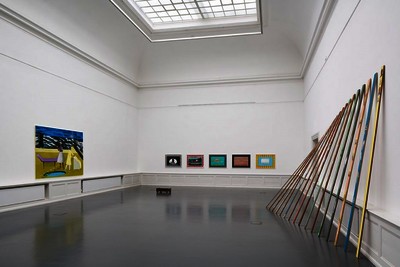Himid, Lubaina (2017) THE TRUTH IS NEVER WATERTIGHT, Badischer Kunstverein, Karlsruhe, Germany, 2017. [Show/Exhibition]
![THE TRUTH IS NEVER WATERTIGHT [thumbnail of THE TRUTH IS NEVER WATERTIGHT]](https://clok.uclan.ac.uk/22972/1.hassmallThumbnailVersion/lh7.jpg)  Preview |
Image (JPEG) (THE TRUTH IS NEVER WATERTIGHT)
- Cover Image
Available under License Creative Commons Attribution Non-commercial No Derivatives. 96kB |
Official URL: http://www.badischer-kunstverein.de/index.php?Dire...
Abstract
The Truth is Never Watertight brings together a wide range of paintings from the 1980s to the present day, as well as cut-outs, painted wooden objects, and works on paper.
Himid chose painting as her medium to deconstruct the Western myth of “Africa”. Her paintings fuse genres, styles and patterns from numerous cultural backgrounds questioning preconceived ideas of belongings. To “make the black presence visible” is a central motif running through all the works selected for the Kunstverein’s exhibition. Himid’s approach to painting is not only two-dimensional, however, for it also moves into the exhibition setting through painting on wooden objects or painted cut out figures. Some of these female figures from the cut-out series Vernet’s Studio (1994) will be seen again after a very long time in the Kunstverein, challenging collective memory and the codification of art-historical facts. Himid studied theatre design in the 1970s, and her interest in spatial orchestrations led to stage-like compositions in and outside of her paintings; or, as the artist herself states, it also channels “a desire to have art in the room, present, in the moment and not distant and framed within a rectangle.” Furthermore theatre opened up opportunities for political thought and action, first in real street settings and then in the imaginary spaces of her artworks.
Himid’s paintings are at once seductive and provocative. Her pictures are mostly figurative, imbued with strong colour and immediate presence. Flight and migration are main topics, as are questions of identity and origin, but also the loss of collective knowledge. Striking patterns, harking back to the influence of African, European, or Islamic ornamentation, develop their own language (“speaking clothes”). A series of Kangas (2008–12) painted on paper, for instance, reference the traditional patterns and motifs of an East African garment, supplemented here with texts by the artist dealing with peril and the will to survive. This atmosphere between harmony and dissonance is characteristic for Lubaina Himid’s works. It is often only at second glance that a reality marked by gender and racial oppression or colonial trauma is visualised. This is the case, for example, in her current series Le Rodeur (2016–17), in which people who are quite elegantly clad meet in bright yet surreal rooms, their rigid posture already hinting at a sense of alienation and unease. In fact, details in the images and the title refer to an incident in 1819 on a slave ship, where all the enslaved passengers and crew contracted an eye infection and went blind. In motifs from the series Plan B (1999/2000), the painted empty rooms are strangely indeterminate and could be places of refuge or captivity. Finally, in the impressive installation Drowned Orchard: Secret Boatyard (2015), sixteen painted wooden panels are leaning against the wall, fanning out into the space at ever-increasing angles. The painted shells, fish, flags, or boats embrace different places and cultures. The symbolism of the sea—a frequently recurring motif—alludes to the mobility of humans, but also to lost sites and the dangers of the ocean depths.
Since 2007 Lubaina Himid has been painting on pages of the daily British liberal newspaper The Guardian. Having read this paper for most of her life Himid has lived through a shift in the representation of black people; from an almost complete absence to a negative representation of black people’s lives. Studying the relationship between image and text it becomes apparent that there is a continuous juxtaposition of reports on violence, crime or other crises and the imagery of black people. Himid paints over some visual information on the page in order to highlight the brutality of this continuous negative representation. The exhibition presents a comprehensive selection from this sequential series called Negative Positives (2007–16).
Repository Staff Only: item control page

 Tools
Tools Tools
Tools
